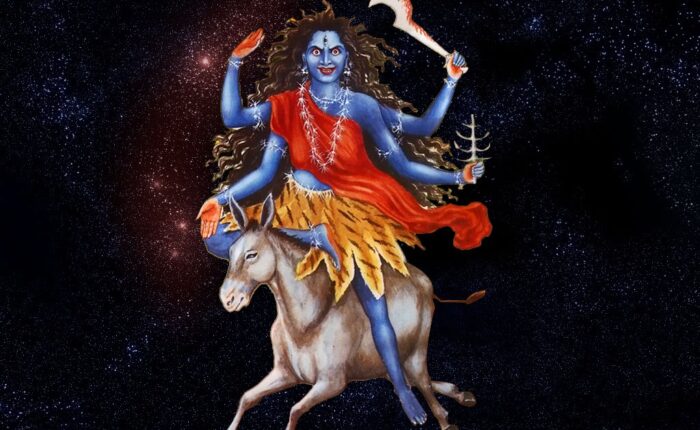Kaalratri – The Seventh Durga

In the continuing battle with Asur warriors, a stage comes when the deity is challenged by two ruling Asur brothers Shumbha and Nishumbha. Chand and Mund were the commanders of the army of the ruling brothers. The atrocities committed by them were narrated to Shiva by Indra. Parvati also heard it. To settle scores with these Asur warriors she created Kalratri who is the presiding deity of the seventh day of Navaratri.
Kaalratri consists of two parts Kaal and ratri. Kaal may have various meanings like time, devourer of time, black etc. Ratri is always connected with night. Night has a reference in Rigveda where 127/10 Sukta describes it. During the night all the working entities find time for sleeping and taking rest. But dangers lurking around in the form of ghosts, evil spirits and night activists like demons and animals are also real. The significance of Kaalratri lies in the belief that she is the only deity to provide protection from evil night activists
Kaalratri and Kali are used almost interchangeably. However, there is some difference between the two. Kaalratri killed demon king Shumbha as Chandi. For others, Kaalratri created Kali who was the fiercest form of the deity riding on a gardabh (donkey). Kali killed Chand and Mund for which she earned the name Chamunda.
Raktabija was blessed with a boon that from every drop of blood spilling out from his body and falling on the ground, a clone of him would be born increasing the number of warriors on the battlefield. To stop such an eventuality, Kali ran around with the Khadga (scimitar) and a broken human skull to collect the blood of Raktabija and drink it herself to prevent the birth of clones. Ultimately Chand, Mund, Shumbha, and Nishumbha were killed as per references found in the Devi Mahatmya part of Markendeya Puran.
In images, Kaalratri / Kali is depicted with dark skin colours almost naked with a tiger skin wrapped around the lower part. They may be depicted with two or four hands holding scimitar, and other weapons, a broken skull etc. She is shown riding on a donkey.
She is considered the most powerful deity by the Vam margis (Tantrics) who dominates over the Maharatri (night of dissolution or Pralaya) and Mohratri (night of delusion when conscious wisdom fails). She is a deity who should be worshipped in Navaratri. Although her form is frightening, she stands for the welfare of devotees and is also known as Shubhankari (bestower of good results). She is the ruler of the Sahasrara chakra.
Mantra:
ॐ देवी कालरात्र्यै नम:
Oṃ Devī Kālarātryai Namaḥ
मां कालरात्रि मंत्र-
Maa Kalratri Mantra:
या देवी सर्वभूतेषु माँ कालरात्रि रूपेण संस्थिता नमस्तस्यै नमस्तस्यै नमस्तस्यै नमो नम:
Prayer:
एकवेणी जपाकर्णपूरा नग्ना खरास्थिता।
लम्बोष्ठी कर्णिकाकर्णी तैलाभ्यक्त शरीरिणी॥
वामपादोल्लसल्लोह लताकण्टकभूषणा।
वर्धन मूर्धध्वजा कृष्णा कालरात्रिर्भयङ्करी॥
Ekaveni Japakarnapura Nagna Kharasthita।
Lamboshthi Karnikakarni Tailabhyakta Sharirini॥
Vamapadollasalloha Latakantakabhushana।
Vardhana Murdhadhwaja Krishna Kalaratrirbhayankari॥
Meaning:
O the one with a single braid of hair, adorned with hibiscus flowers around her ears, naked (wearing directions as clothes), present on a donkey. Her lips are long, wearing earrings on her ears and her body is smeared with oil. Her left leg is adorned with metal thorny coils like a creeper as her ornament. The one who increases prosperity, the one in dark blue colour, the Goddess Kalarathri, the terrible one to the wicked (I bow to you).
I am a Vedic astrologer by profession. I have done Jyotish Acharya from Bhartiya Vidya Bhawan. I am devoted to my Sadguru Shri Sai Nath of Shirdi. I am also interested in spirituality. I love to guide people.